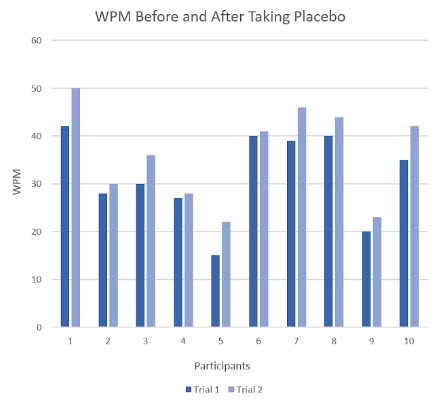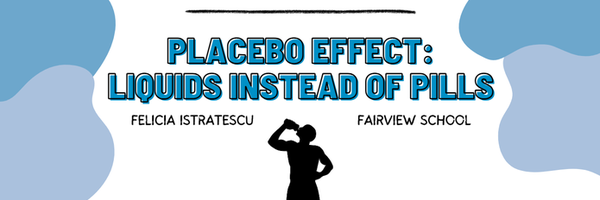Placebo Effect - Liquids Instead of Pills: Felicia Istratescu
Grade 9
Presentation
Hypothesis
If participants think they are drinking an energy drink, then I think they will type faster, because the expectation that they should be able to type faster will strengthen their mentality, pushing them to get a higher WPM*.
*WPM stands for words per minute, the measurement of typing speed
Research
The Placebo Effect
- placebo effect: phenomena where patient’s symptoms are treated but the cure isn’t real; the patient believes it will treat them
- placebos are most commonly pills used to treat patients except they’re not real cures
- patients report feeling better after taking placebos, even after being told it’s a placebo
- open-label placebos
- when patients knowingly take placebos → sometimes used in clinical studies
- placebo effect can still occur; patients have still reported feeling better
- can be due to physical pill taking actions like opening a pill bottle or swallowing a pill
- can be due to natural changes in symptoms (symptoms coincidentally decreasing when pill is taken)
How do placebos work?
- not exactly known how the placebo effect works but theories include:
- conditions resolve by themselves and the placebos being present is a coincidence
- placebo encourages people to take better care of themselves and improve their diet, sleep schedule, and workout routines
- placebos might alter people’s perception of their problems, eg. a pain that was previously interpreted as a sharp stab can be interpreted as a slight tingling sensation after the placebo was taken
- patients expect to feel better after taking the placebo so it may reduce anxiety and stress levels which makes them feel better
- placebos can affect brain chemicals and trigger endorphin releases
- research has shown that people’s brains respond to imagined scenes the same way as real visualized scenes so placebos can help the brain remember the times before the problems so the brain forgets the symptoms
- confirmation bias → expecting to get better, people might be focusing more on signs that they’re getting better and dismissing signs that they’re getting worse
- often when taking pills, you feel better, and it’s possible for your brain to recreate that memory when taking a placebo
- other factors that affect placebos:
- patient’s attitude
- realism of placebo → the more realistic it looks the more the patient is likely to believe in it
- doctor-patient relationship → patient is more likely to believe in the placebo if they trust their doctor and have a personal relationship with them
- placebos are also used to help test the effectiveness of new medicines or treatments
- one group takes actual medication and the other group takes the placebo
- in some cases the researchers don’t know which group took which (that’s called a double-blind test)
- about ⅓ of people taking placebos report having their symptoms cured
- placebo effect doesn’t work on “imaginary” sicknesses
“as the mind can contribute to a physical disorder, it can also contribute to its cure”
- placebos can cause unwanted side effects including nausea, drowsiness, and allergic reactions like skin rashes
Nocebo effect
- negative outcomes because patients were expecting negative effects
- can be caused when person taking the treatment is told the risks and negative side effects
Questions I have:
- I have chronic migraines - the pills I take sometimes work after an hour, but other times take the whole night. Sometimes I don’t take pills because I’m not allowed to take them too frequently, and the migraines still go away. Are the pills actually helping me? If I knowingly take a placebo but try to gaslight myself into thinking it’s a real pill, will my migraines go away?
Variables
Manipulated variable: whether participants are taking the “energy drink” or not
Responding variable: typing score (WPM) before and after taking the fake sports drink
Controlled variables: typing test for each person, same “energy drink” they are drinking, amount of “energy drink” participants must consume
Procedure
Materials
-
electronic device with keyboard (eg. computer, laptop)
-
container to hold placebo energy drink
-
measuring cup
-
teaspoon
-
tap water (¼ cup per person) ~15°C
-
granulated sugar (½ teaspoon per person)
-
food coloring (1 drop per person)
Pre-trial Procedure (Creating the Placebo)
Per participant (single portion)
-
Pour ¼ of a cup of slightly chilled drinking water (~15°C) into a clean, dry container.
-
Put ½ of a teaspoon of granulated sugar into that same container and stir until the sugar is fully dissolved.
-
Put a drop of food coloring into the mixture you created in the previous steps and stir until the food coloring is uniformly mixed.
Trial 1 Procedure
- Ask the participant(s) which computer/laptop keyboard they are most comfortable typing on. (This gives participants the highest chance of performing at their best)
- Allow participants to do this 1-minute typing test whenever they are ready.
- Record their WPM score.
Trial 2 Procedure
- Give participants ¼ cup of the Placebo energy drink that you made in the Pre-trial Procedure and convince them it’s a real energy drink. Wait 10 minutes before continuing to the next step (real energy drinks take ~10 minutes to kick in).
- Allow participants to do this 1-minute typing test again on the same keyboard as in Trial 1.
- Record their WPM score.
- Compare it to their score from the first trial.
Observations
Table used to record data:
|
Number |
Biological Gender |
Age |
Trial 1 WPM |
Trial 2 WPM |
- “Number” column is for referral purposes + to keep participants anonymous
- “Biological Gender” → possible physical advantages
- “Age” → possible physical advantages
Tuesday, December 6
|
Number |
Biological Gender |
Age |
Trial 1 WPM |
Trial 2 WPM |
|
1 |
Female |
15 |
42 |
50 |
|
2 |
Female |
44 |
61 |
67 |
|
3 |
Male |
50 |
60 |
62 |
Observations:
- placebo effect is working so far; all of their scores improved after they thought they drank an energy drink (qualitative observation)
- person 1 seemed suspicious of energy drink when she took it - later told me it was tasteless
- (qualitative observation)
- person 2 also seemed suspicious of the energy drink → i might add a bit of vanilla
- (qualitative observation)
Thursday, December 8
- I tried adding a drop of vanilla to a single-person portion of the energy drink but it didn’t taste like an energy drink; flavors don’t coincide well
→ I’ll keep the energy drink the same
Thursday, January 4
|
Number |
Biological Gender |
Age |
Trial 1 WPM |
Trial 2 WPM |
|
4 |
Male |
50 |
27 |
28 |
|
5 |
Female |
42 |
15 |
22 |
|
6 |
Male |
12 |
40 |
41 |
Observations:
- person 5 was suspicious of energy drink (all the females who’ve participated so far were suspicious of the energy drink) → I’m going to change the ¼ tsp of sugar per person to ½ tsp of sugar per person
Saturday, January 20
Final tests:
|
Number |
Biological Gender |
Age |
Trial 1 WPM |
Trial 2 WPM |
|
7 |
Female |
14 |
28 |
40 |
|
8 |
Male |
12 |
50 |
58 |
|
9 |
Male |
52 |
60 |
69 |
|
10 |
Female |
47 |
40 |
55 |
Observations:
- no one seemed suspicious of the energy drink (qualitative observation)
Analysis
Data

Conclusion
My hypothesis was partly correct, in the fact that almost everyone’s WPM improved after taking the placebo. For the other part of my hypothesis, I can’t be 100% sure if that’s why their WPMs improved, but I think the placebo worked because everyone expected to be able to type faster because energy drinks have been proven to increase your focus and energy, so unknowingly, they became more focused and were able to type faster.
Application
Importance of Data & Real-Life Application
This data shows that the placebo effect can be applied in situations other than pill treatments, to push people to perform at their best. This also shows that people are guided by their beliefs and if they believe in something, their subconsciousness will guide them towards it.
What would I change?
If I redid this experiment I would do a double-blind version; in the second trial, I’d have a bottle of a placebo energy drink and another bottle of a real energy drink and I’d ask participants to drink from 1 of them when I turn around, so neither the participants or I don’t know which is which. After they drink from one of the bottles and do the typing test, I’d ask them to point out which bottle they drank from so I could compare results from both groups (the people who drank the placebo vs. the people who drank the real energy drink).
Sources Of Error
Possible Sources of Error
Most of the participants did better in the second trial but that might’ve been because they were more warmed up after the first trial and knew what to expect, versus in the first trial, where they might’ve been unsure about how the test was going to work.
The participants might’ve thought of the first trial as a warm-up and pushed themselves to do better in the second trial, which would have nothing to do with the placebo. That would be a result of their own mentality. This possible source of error could’ve been avoided if I’d switched the order of the trials which would have the participants take the placebo for the first trial, and do the second trial without taking the placebo, to see if they just had a stronger mentality for the second round.
Citations
Sources
Slidesgo: Free Google Slides themes and Powerpoint templates, https://slidesgo.com/ . Accessed 26 January 2024.
“Calgary Youth Science Fair.” Calgary Youth Science Fair – Leading young minds into the future, https://www.cysf.org/ . Accessed 26 January 2024.
“Check your WPM score with a free one-minute test.” Typing.com, https://www.typing.com/student/typing-test/1-minute . Accessed 26 January 2024.
Nandula, Ansh. “The Placebo Effect, and why we should believe.” Wikipedia, 30 November 2022, https://uk.style.yahoo.com/placebo-effect-why-believe-ansh-202344722.html?guccounter=1&guce_referrer=aHR0cHM6Ly93d3cuZ29vZ2xlLmNvbS8&guce_referrer_sig=AQAAAEz2LqKg5eb81YV0zmwEKb5RPlVu6Uu9Lp_HprcaBIOnYExZ9GKc6w1s7KD1aBVbXflOkg89XeLwKUA12fc2ciDnREE-r6COWsId2 . Accessed 26 January 2024.
“Placebo effect.” Better Health Channel, https://www.betterhealth.vic.gov.au/health/conditionsandtreatments/placebo-effect . Accessed 26 January 2024.
Resnick, Brian. “The weird power of the placebo effect, explained.” Vox, 7 July 2017, https://www.vox.com/science-and-health/2017/7/7/15792188/placebo-effect-explained . Accessed 26 January 2024.
Sinclair, Miranda. “Science Fair Projects Using the Placebo Effect - Synonym.” Classroom, https://classroom.synonym.com/science-projects-using-placebo-effect-8267628.html . Accessed 26 January 2024.
Acknowledgement
Thank you to my family for continuously supporting me throughout the work I do, and my Science Fair Coordinator for answering every question I have and for helping me throughout the Science Fair process.
I would also like to thank all the participants in my project; without them, I would have no data and no project.
Without all these amazing people, my project would not be what it is.
Lastly, thank you to the CYSF for providing students with the opportunities to showcase their skills and creativity.

